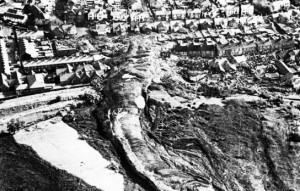On this day in 1966, 116 children from the South Wales village of Aberfan were suffocated in their classrooms, buried alive – just yards from their parents’ homes – by a forty-feet-high avalanche of liquefied coal waste that swept down the hillside after becoming dislodged from its main ‘tip’ by several days of continuous rain. Had the disaster happened just 24 hours later, all the children would have been safe at home on Half-Term Holiday. Had the wave of slurry hit just five minutes before at 9.10 am, most of the children would have been protected by the shelter of their school assembly hall. But the black wave hit the school barely minutes after the children had settled down at their desks, and each classroom at Aberfan school faced directly on to the hillside whence came that black tidal wave of death. And such was its power that beyond 11 am that day, no more survivors would be pulled out of that sticky black tomb alive.
Compounding the tragedy of this national disaster was its dreadful inevitability, for these large tips that teetered precariously above Aberfan had for fifty long years been the subject of local people’s anxiety. But mining chiefs had always been too remote to pay attention to such fears, and the poor relationship between miners and their bosses was – in the valleys of South Wales – the stuff of legend. I should know because I was a child of those very same valleys, and the Aberfan Disaster took place on my ninth birthday. Indeed, I spent my ninth birthday in Deri – just four miles away from Aberfan – surrounded by sobbing aunts, parents and grandparents as the BBC news reports painted an ever gloomier picture. For the National Coal Board, this PR disaster was almost as carelessly and cynically mismanaged as the coal tips that overlooked Aberfan. For rather than rushing to the accident site, Coal boss Lord Robens instead travelled to his investiture as chancellor of the University of Surrey, while Coal Board bosses covered for him. Worse still, Robens further exacerbated the dire public relations of the Coal Board by refusing to allow Coal Board funds to pay for the Aberfan clear up, then by claiming on TV that the disaster had been unavoidable even though the tip that destroyed the school had been dumped across a large spring well known to older locals and still marked upon Ordnance Survey maps.
No Coal Board executives lost their jobs over Aberfan, nor did the government accept Lord Robens’ resignation. Having led the Coal Industry through a then rare strike-free period, he was considered far too valuable to Harold Wilson’s Labour Government to be let go. And so the people of Aberfan – victims and pawns of one of the world’s most cynical industries – were left to deal with their tragedy virtually alone. Shouts of ‘Murderers!’ were heard as the names of the child victims were read out at the public enquiry. One grief stricken father, determined to oppose the official causes of this child’s death – ‘by asphyxia and multiple injuries’ – insisted instead that the cause of death on the death certificate should read:
“Buried alive by the National Coal Board”.
[Written by Julian Cope]



One Response to 21st October 1966 – The Aberfan Disaster